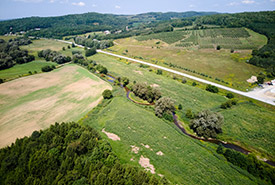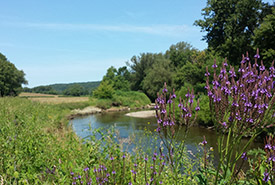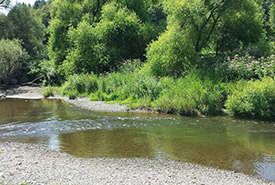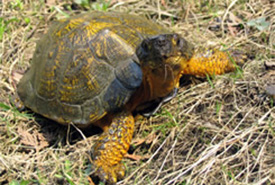Frelighsburg — Restoring shoreline in the heart of a village

Rivière aux Brochets, QC (Photo by Alex Chabot)
Soil doesn’t stay in place on its own. The reason it stays put is largely because what’s beneath the surface. Roots act as anchors, holding soil captive in intricate underground nets. This is a very good thing, because without roots, soil would be carried off by rain, floods, waves and wind...it would end up scattered everywhere! Roots are, therefore, extremely important.
But what happens when a piece of land is cleared and the roots are removed? And what if that land is near a river that floods every spring? The soil will gradually spread, carrying a large quantity of minerals and pesticides into the water, where they don’t belong. It is important to protect vegetation below the spring flood line, as well as all wetlands. By keeping this essential root network intact, we can prevent sediment runoff and protect the natural areas.

Rivière aux Brochets, QC (Photo by Charlotte Dwyer)
The Nature Conservancy of Canada (NCC) has recently acquired a property in the heart of the village of Frelighsburg that needs a helping hand from the local community. The goal is to restore the “freedom space” (the area where the river overflows its banks during flooding) of Rivière aux Brochets, as well as adapt agricultural practices and create a suitable home for wildlife.
A healthy shoreline?
By adding a few metres of vegetation along the shoreline, we’ll be able to solve a host of problems! The soil will no longer be carried off into the river and it will remain mineral-rich and suitable for agriculture. In addition, the roots will absorb some of the water from springtime floods. A robust shoreline is the best solution for both the river and soil.

Rivière aux Brochets, QC (Photo by Charlotte Dwyer)
That’s something to think about the next time you’re about to mow your cottage lawn down to the shoreline. By leaving just a few metres of natural vegetation, you can create a healthy environment that will attract birds, turtles and frogs. It’s easy to be nature-friendly!
What about agriculture?
Good agricultural practices mean respecting the soil and environment and limiting the use of chemical fertilizers and pesticides. It also means choosing the right plants. Think how much harder it would be to grow bananas in Quebec compared to radishes!
The property acquired by NCC will continue to be used for agriculture, since the area is perfect for growing hay. It will benefit the region, because the roots aren’t pulled up every year; only the top part of the plant is harvested.
Water, soil...animals?

Curious wood turtle (Photo by Ryan M. Bolton)
This is a win-win solution for everyone, including animals. NCC hopes that the vegetation, restored shoreline and hay field will encourage a variety of animals to make this little corner of paradise their home. Field birds, of which many species are endangered, and wood turtles, an at-risk species, will especially benefit from this restored environment. We’ll be putting out the welcome mat for all our reptilian and feathered friends!
NCC thanks our financial partners for their support in acquiring this land and the residents of Frelighsburg for all their help.
Jean-Martin Fortier, his wife, Maude-Hélène Desroches, and Julie Bellefroid



as well as private donations





